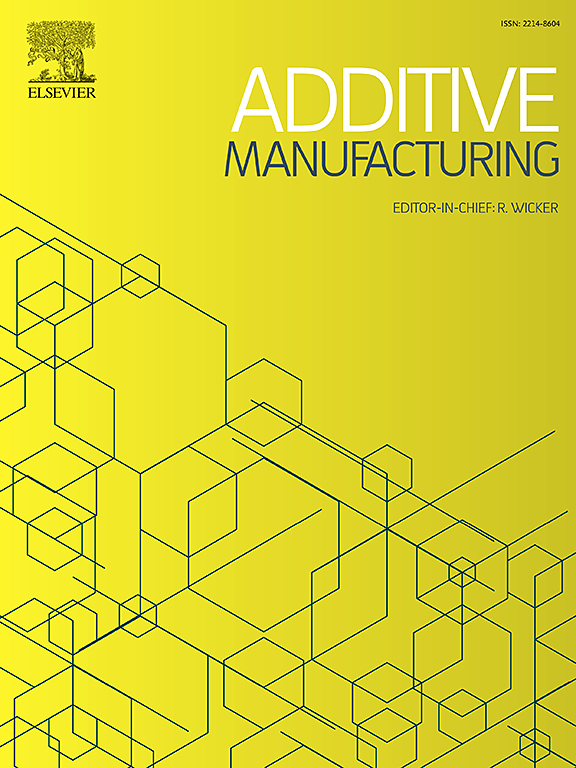Effects of laser powder bed fusion parameters on the delta-ferrite to austenite phase transformation in duplex stainless steels
IF 11.1
1区 工程技术
Q1 ENGINEERING, MANUFACTURING
引用次数: 0
Abstract
Laser powder bed fusion (LPBF) of 2205 duplex stainless steels is attractive for making complex shaped engineering parts for applications requiring unique combinations of strength-toughness-corrosion properties. However, as-built parts possess highly non-equilibrium microstructures (>98 % δ-ferrite). The desirable balanced austenite/δ-ferrite microstructure can be recovered after a brief heat treatment, potentially achieving much finer duplex microstructures than in wrought counterparts. However, systematic understanding of how LPBF parameters control the microstructural characteristics of the parent δ-ferrite and, hence, the transformed austenite product, is currently missing. We aim to close this gap by establishing the process-microstructure-property relationship using multi-scale characterization and nano-indentation. We compare as-built and heat-treated conditions fabricated with eight different combinations of laser power and scan speed. We show how variations in residual stress, texture, and characteristics of dislocations and inclusions in the parent δ-ferrite control the phase fraction, morphology, grain size, texture, and variant selection of the daughter austenite. A higher dislocation density in δ-ferrite is found to be associated with lower laser power and/or higher scan speed, contributing to higher hardness in as-built δ-ferrite and smaller intragranular austenite grain sizes in heat-treated conditions. Higher residual stress and/or stronger δ-ferrite texture contribute to higher austenite phase fractions. Intragranular austenite variant selection is revealed to be related to the complexity of δ-ferrite dislocation structures, and results in significant hardness increments in the heat-treated conditions. These findings highlight the capability of microstructural engineering via adjusting LPBF parameters and controlling materials performance through manipulating solid-state phase transformations.
激光粉末床熔合参数对双相不锈钢δ -铁素体向奥氏体相变的影响
2205双相不锈钢的激光粉末床熔合(LPBF)对于制造复杂形状的工程部件具有吸引力,用于需要独特的强度-韧性-腐蚀性能组合的应用。然而,成品具有高度非平衡的微观结构(>;98 % δ-铁氧体)。经过短暂的热处理后,可以恢复理想的平衡奥氏体/δ-铁素体微观组织,可能获得比锻造同类更精细的双相组织。然而,对于LPBF参数如何控制母晶δ-铁素体的微观结构特征,从而控制转变的奥氏体产物,目前还缺乏系统的理解。我们的目标是通过使用多尺度表征和纳米压痕建立工艺-微观结构-性能关系来缩小这一差距。我们比较了用八种不同的激光功率和扫描速度组合制造的成品和热处理条件。我们展示了残余应力、织构以及母晶δ铁素体中位错和夹杂物特征的变化如何控制子晶奥氏体的相分数、形貌、晶粒尺寸、织构和变体选择。研究发现,δ铁素体中较高的位错密度与较低的激光功率和/或较高的扫描速度有关,这有助于在热处理条件下形成较高的δ铁素体硬度和较小的晶内奥氏体晶粒尺寸。较高的残余应力和/或较强的δ-铁素体织构导致较高的奥氏体相分数。晶内奥氏体变异选择与δ-铁素体位错结构的复杂性有关,并导致热处理条件下的硬度显著增加。这些发现强调了通过调整LPBF参数和通过操纵固态相变来控制材料性能的微结构工程能力。
本文章由计算机程序翻译,如有差异,请以英文原文为准。
求助全文
约1分钟内获得全文
求助全文
来源期刊

Additive manufacturing
Materials Science-General Materials Science
CiteScore
19.80
自引率
12.70%
发文量
648
审稿时长
35 days
期刊介绍:
Additive Manufacturing stands as a peer-reviewed journal dedicated to delivering high-quality research papers and reviews in the field of additive manufacturing, serving both academia and industry leaders. The journal's objective is to recognize the innovative essence of additive manufacturing and its diverse applications, providing a comprehensive overview of current developments and future prospects.
The transformative potential of additive manufacturing technologies in product design and manufacturing is poised to disrupt traditional approaches. In response to this paradigm shift, a distinctive and comprehensive publication outlet was essential. Additive Manufacturing fulfills this need, offering a platform for engineers, materials scientists, and practitioners across academia and various industries to document and share innovations in these evolving technologies.
 求助内容:
求助内容: 应助结果提醒方式:
应助结果提醒方式:


